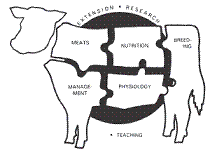Animal Science, Department of

Nebraska Beef Cattle Reports
Date of this Version
January 2007
Abstract
Seventy-nine crossbred summer and fall-born steers and heifers were stratified by weight, calving group, and sex and assigned to treatment or control. Yearlings in the treatment group (TRT; n = 40) grazed native summer Sandhill range and had access to ad libitum dried distillers grains (DDG) pellet in a creep feeder for 54 days of a 63-day grazing period. Control (CON; n = 39) yearlings grazed in an adjacent pasture without DDG. Immediately after the grazing period, yearlings were placed in a feedlot and fed to a similar backfat endpoint. Individual forage and DDG intake estimates and animal ADG and carcass characteristics were used to determine the value of DDG to TRT yearlings at the end of the grazing period and at harvest. Intake of DDG averaged 11 lb/d DM. Summer ADG was greater (P<0.01) for TRT (2.8 lb/day) than CON (1.9 lb/day). Yearlings previously allowed access to DDG gained more (P<0.01) during the first 30 days in the feedlot (2.9 vs. 2.4 lb/d for TRT and CON, respectively). Yearlings allowed access to DDG were harvested 14 days before CON (138 DOF). Final weight, ADG, and carcass characteristics were similar between TRT and CON. There was a tendency (P=0.15) for TRT cattle to have a higher percentage grading choice, (67 vs. 51% for TRT and CON, respectively). The value of DDG to yearlings grazing Sandhill range was greater than the estimated cost at both the grazing and harvest endpoints.


Comments
Published in 2007 Nebraska Beef Cattle Report. Copyright © 2006 The Board of Regents of the University of Nebraska.